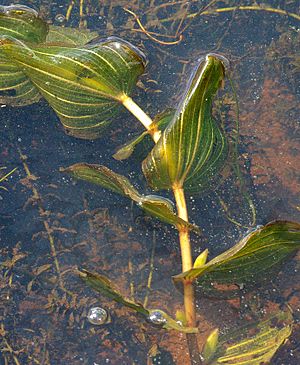Potamogeton facts for kids
Quick facts for kids Potamogeton |
|
|---|---|
 |
|
| Potamogeton perfoliatus | |
| Scientific classification | |
| Kingdom: | |
| (unranked): | |
| (unranked): | |
| Order: | |
| Family: |
Potamogetonaceae
|
| Genus: |
Potamogeton
|
| Species | |
|
80-100, see text |
|
Potamogeton is a group of aquatic plants, often called pondweed. These plants live in freshwater places like ponds, lakes, and slow-moving rivers. They are part of the plant family called Potamogetonaceae. The name Potamogeton comes from Greek words meaning "river neighbor," which makes sense because they grow near or in rivers. Pondweeds are a very important food source for many fish and other water creatures.
Contents
What is Pondweed?
Pondweeds are a type of plant that grows completely or partly underwater. They are found all over the world, from cold regions to warm ones. There are about 80 to 100 different kinds, or species, of pondweed. Each species has its own unique features, but they all share the basic characteristics of living in water.
Where Does Pondweed Live?
Pondweeds prefer calm or slow-moving freshwater. You can find them in:
- Lakes
- Ponds
- Rivers
- Canals
- Ditches
They often grow in places where the water is not too deep, allowing sunlight to reach them. They can grow in both clear and slightly murky water.
What Does Pondweed Look Like?
Pondweeds have long, flexible stems that can reach the water's surface. Their leaves come in different shapes and sizes depending on the species. Some pondweeds have broad, floating leaves that look like lily pads. Others have narrow, ribbon-like leaves that stay submerged underwater.
Many pondweeds also produce small, often green or brownish, flowers. These flowers usually grow on a spike that sticks out of the water. After flowering, they produce small fruits that contain seeds.
Why is Pondweed Important?
Pondweeds play a vital role in freshwater ecosystems. They are like the "lungs" of the water, providing many benefits:
- Food Source: Many animals, including ducks, geese, fish, and insects, eat pondweed leaves, stems, and seeds.
- Habitat and Shelter: The dense underwater growth of pondweeds provides hiding places and shelter for young fish and other small aquatic animals.
- Oxygen Production: Like all green plants, pondweeds perform photosynthesis. This process releases oxygen into the water, which is essential for fish and other aquatic life to breathe.
- Water Quality: Pondweeds help to stabilize the bottom of lakes and rivers, preventing soil from washing away. They can also absorb extra nutrients from the water, which helps keep the water clean.
How Does Pondweed Reproduce?
Pondweeds can reproduce in several ways:
- Seeds: They produce seeds from their flowers, which can then grow into new plants.
- Rhizomes: Many species have underground stems called rhizomes. These rhizomes can spread and produce new shoots, allowing the plant to grow in large patches.
- Turions: Some pondweeds form special buds called turions. These are tough, compact buds that can survive harsh conditions, like winter, and then sprout into new plants when conditions improve.
This ability to reproduce in different ways helps pondweeds spread and thrive in various freshwater environments.
Images for kids
See also
 In Spanish: Espiga de agua para niños
In Spanish: Espiga de agua para niños


